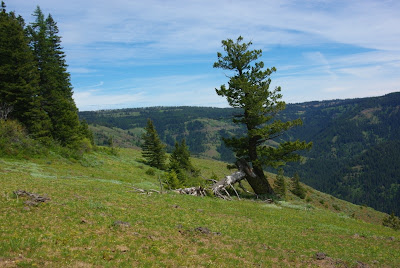 |
| (If you click on the photos you can see them larger.) |
It has been a long time since my last wildflower wander. It's been years since I saw spring on Coyote Ridge, in the Blue Mountains of Oregon. My first time here was about this time of year, but my little guy must have been only around 3 or 4. In my minds eye I picture him bouncing energeticly through the flowers, singing a happy song. This weekend he stalked good photos with an intense focus, and only came to see me when he wanted to know about something. He's learned a lot since then. He remembers the names of almost all the wildflowers.
Out in the west side of the meadow is a heavy, old picnic table, a very, long hike from the parking area. It has obviously been there many years, almost sunk to it's waist in meadow mud. The sturdy benches became a resting place once again, while its top hosted supper carried in by knapsack. I laid down and watched a Red-shafted Flicker dart from a old tree snag, to other living trees and back again. Could there be a nest in the back side? Unseen birds sang Sabbath melodies for me and the Creator.
Lupines supplied the intense blue.
Wild Onions sparkled white in every direction. A yellow Lomatium (maybe Biscuit Root) filled in the yellow base.
If you weren't looking closely, you'd think that was all that was there. But no, I found more flowers, with the aid of my son, of course. I told him there would not be any Camas Lilies, even if some grew there, they would be finished blooming, but he proved me wrong.
Balsam Root grew on the steeper slopes. I thought it would be finished too, because we have Balsam Root in the valley in March. But Coyote Ridge is over 5,000 feet elevation.
There were plenty of these yellow orbs of sunshine still open.
Another yellow was the Mountain Banner. It looks a bit like a yellow lupine, but grows more bushy and tall. Lewis and Clark spotted some on their 1805 trip to the west, too.
Those who were looking closely found this unusual pink flower. It is a kind of wild buckwheat.
I loved the white webbing wrapped around those cute little dots of pink.
The Blue Mountains of Oregon really are blue at this time of year.
Pioneers in the westward migrating wagon trains had to go over them to get to Western Oregon. These steep slopes provided almost insurmountable challenges. Those amazing people walked up and down those steep slopes beside their oxen. They likely hoped they would never have to go back there again.
But I hope to go again. Soon.
I think it would fun to set up a backpacking tent, and experience another
Wildflower Morning,
this time on the west side of Picnic Table Meadow.












It's looking absolutely beautiful on the other side of the mountain! I love that meadow. If it is the one I think it is --- I have not visited it in years. It's time for a trip back again. This is a fantastic spring for wildflowers in the Blue's. I'm enjoying it so much!
ReplyDelete